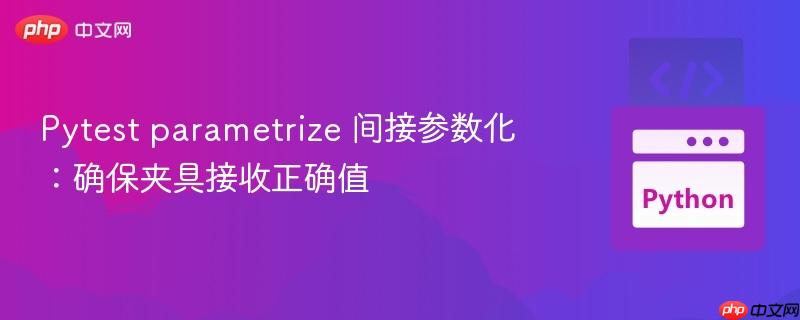
在使用 pytest 进行参数化测试时,当 `parametrize` 装饰器与同名夹具结合使用时,可能会遇到夹具接收到参数值而非其应提供的对象的问题。本文将深入探讨 pytest `parametrize` 的 `indirect=true` 参数,解释其工作原理,并提供示例代码,确保你的参数化夹具能够正确地接收和处理测试参数,从而避免常见的误解和错误,实现灵活高效的测试。
在 Pytest 中,@pytest.mark.parametrize 装饰器和 fixture 是实现灵活、可重用测试代码的关键工具。parametrize 允许你为同一个测试函数或类运行多组不同的输入参数,而 fixture 则提供了测试前置条件设置和后置清理的机制。然而,当这两者结合使用时,如果不理解其底层机制,可能会遇到意料之外的行为。
默认情况下,@pytest.mark.parametrize("arg_name", [value1, value2]) 的作用是为测试函数或类创建一个名为 arg_name 的局部变量,并依次将 value1、value2 赋值给它,从而运行多组测试。如果此时存在一个与 arg_name 同名的 fixture,那么 parametrize 创建的局部变量会“遮蔽”掉这个 fixture。这意味着,测试函数或类将直接接收到 parametrize 提供的参数值,而不是由同名 fixture 经过处理或 yield 出来的对象。
考虑以下场景:你希望通过参数化来选择不同的浏览器进行端到端测试,并使用一个 fixture 来实例化和管理浏览器对象。
conftest.py 中的浏览器夹具定义:
# conftest.py
import pytest
from selenium import webdriver
from selenium.webdriver.chrome.options import Options as ChromeOptions
from selenium.webdriver.firefox.options import Options as FirefoxOptions
def create_browser(browser_name, headless=True):
"""根据名称和是否无头模式创建浏览器实例"""
if browser_name == "chrome":
options = ChromeOptions()
if headless:
options.add_argument("--no-sandbox")
options.add_argument("--headless")
options.add_argument("--disable-dev-shm-usage")
options.add_argument("--disable-gui")
return webdriver.Chrome(options=options)
elif browser_name == "firefox":
options = FirefoxOptions()
if headless:
options.add_argument("--headless")
options.add_argument("--disable-gui")
return webdriver.Firefox(options=options)
else:
raise ValueError(f"Unsupported browser: {browser_name}")
@pytest.fixture(scope="class")
def browser_fixture(request):
"""
一个参数化的夹具,根据请求参数创建并管理浏览器实例。
request.param 预期是一个包含 (browser_name, headless) 的元组。
"""
browser_name, headless = request.param
browser = create_browser(browser_name, headless=headless)
yield browser # 产出浏览器对象供测试使用
browser.quit() # 测试结束后关闭浏览器测试类中的错误用法示例:
# test_e2e.py (错误示例)
import pytest
from django.core import management
from django.contrib.auth.models import User # 假设 Django User 模型可用
@pytest.mark.parametrize("browser_fixture", [("chrome", False)]) # 缺少 indirect=True
@pytest.mark.slow()
class TestEndToEnd:
@pytest.fixture(autouse=True)
def setup(self, browser_fixture, live_server):
# 运行 Django 管理命令以设置测试数据
management.call_command("create_project_data", verbosity=0)
self.browser = browser_fixture
# 此时,self.browser 得到的不是 WebDriver 对象,而是元组 ('chrome', False)
self.live_server_url = live_server.url
def login_user(self, username=None, password="test", user=None):
# 简化登录逻辑,实际会与 self.browser 交互
if user:
username = user.username
print(f"Logging in user: {username} (using browser: {getattr(self.browser, 'name', 'N/A')})")
# self.browser.get(self.live_server_url + "/login/")
# ... 登录操作 ...
def test_as_admin(self):
standard_user = User.objects.first()
if not standard_user:
standard_user = User.objects.create_user(username="admin_user", password="test")
self.login_user(user=standard_user)
# 尝试使用 self.browser.get() 将会失败,因为 self.browser 是一个元组
# self.browser.get(self.live_server_url + "/mills/")
# assert "Mills" in self.browser.title
print(f"Test 'test_as_admin' would run for browser: {getattr(self.browser, 'name', 'N/A')}")
在上述错误示例中,TestEndToEnd 类中的 setup 夹具接收到的 browser_fixture 并不是 conftest.py 中定义的 browser_fixture 所 yield 出来的 webdriver.Chrome 对象,而仅仅是 parametrize 装饰器中提供的参数值元组 ('chrome', False)。这是因为 parametrize 默认行为是创建一个同名的局部变量来存储参数值,从而遮蔽了同名的 fixture。
为了解决这个问题,我们需要告诉 Pytest,@pytest.mark.parametrize 提供的参数值不应直接作为测试函数的变量,而是应该作为参数传递给同名的 fixture。这正是 indirect=True 参数的作用。
indirect=True 的工作原理:
当你在 @pytest.mark.parametrize 中为某个参数名设置 indirect=True 时,Pytest 会查找一个与该参数名同名的 fixture。然后,它会将 parametrize 提供的参数值作为 request.param 属性传递给这个 fixture。fixture 接着会执行其逻辑(例如,创建浏览器实例),并 yield 出最终的对象,这个对象才是测试函数或类真正接收到的值。
测试类中的正确用法示例:
# test_e2e.py (正确示例)
import pytest
from django.core import management
from django.contrib.auth.models import User # 假设 Django User 模型可用
@pytest.mark.parametrize("browser_fixture", [("chrome", False)], indirect=True) # <-- 关键:添加 indirect=True
@pytest.mark.slow()
class TestEndToEnd:
@pytest.fixture(autouse=True)
def setup(self, browser_fixture, live_server):
management.call_command("create_project_data", verbosity=0)
self.browser = browser_fixture # 现在 self.browser 将是 WebDriver 对象
self.live_server_url = live_server.url
print(f"Browser setup complete: {self.browser.name}")
def login_user(self, username=None, password="test", user=None):
if user:
username = user.username
print(f"Attempting to login user: {username} using browser: {self.browser.name}")
# 实际的登录逻辑,与 self.browser 交互
self.browser.get(self.live_server_url + "/admin/login/") # 示例:导航到登录页
# 假设存在 id 为 'id_username' 和 'id_password' 的输入框
# self.browser.find_element("id", "id_username").send_keys(username)
# self.browser.find_element("id", "id_password").send_keys(password)
# self.browser.find_element("css selector", "input[type='submit']").click()
print(f"Login logic simulated for user: {username}")
def test_as_admin(self):
standard_user = User.objects.first()
if not standard_user:
standard_user = User.objects.create_user(username="admin_user", password="test")
self.login_user(user=standard_user)
self.browser.get(self.live_server_url + "/mills/")
assert "Mills" in self.browser.title
print(f"Test 'test_as_admin' passed for browser: {self.browser.name}, title: {self.browser.title}")
通过添加 indirect=True,Pytest 会将 ("chrome", False) 这个元组传递给 browser_fixture 夹具的 request.param。browser_fixture 夹具会使用这个元组来创建 Chrome 浏览器实例,并 yield 出这个实例。最终,TestEndToEnd 类中的 setup 夹具会正确地接收到 webdriver.Chrome 对象,从而使得 self.browser 成为一个可用的浏览器驱动。
indirect 参数不仅可以设置为 True,还可以是一个包含需要间接化的参数名的列表,例如 indirect=["browser_fixture"]。这在需要混合直接参数化和间接参数化的场景中非常有用。
# 混合直接和间接参数化的例子
@pytest.mark.parametrize(
"browser_fixture, test_scenario",
[
(("chrome", False), "scenario_A"),
(("firefox", True), "scenario_B")
],
indirect=["browser_fixture"] # 只有 browser_fixture 是间接的
)
class TestMixedParametrization:
def test_something(self, browser_fixture, test_scenario):
# browser_fixture 是 WebDriver 对象
# test_scenario 是字符串 "scenario_A" 或 "scenario_B"
print(f"Running {test_scenario} with {browser_fixture.name}")
assert browser_fixture.name in ["chrome", "firefox"]
assert test_scenario in ["scenario_A", "scenario_B"]@pytest.mark.parametrize 和 fixture 是 Pytest 中功能强大的组合,但理解它们之间的交互至关重要。当 parametrize 的参数名与 fixture 名相同时,indirect=True 参数是确保 Pytest 将参数值正确地传递给 fixture 进行处理的关键。掌握这一机制,可以帮助你构建更健壮、更灵活的参数化测试套件,有效管理测试资源。
以上就是Pytest parametrize 间接参数化:确保夹具接收正确值的详细内容,更多请关注php中文网其它相关文章!

每个人都需要一台速度更快、更稳定的 PC。随着时间的推移,垃圾文件、旧注册表数据和不必要的后台进程会占用资源并降低性能。幸运的是,许多工具可以让 Windows 保持平稳运行。

Copyright 2014-2025 https://www.php.cn/ All Rights Reserved | php.cn | 湘ICP备2023035733号